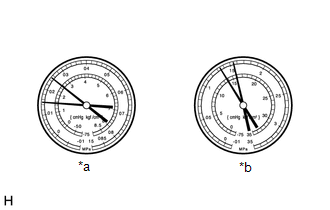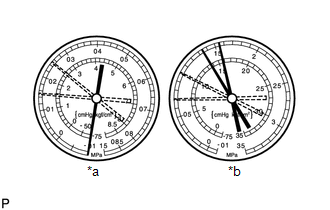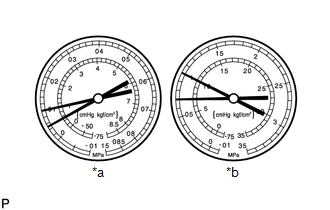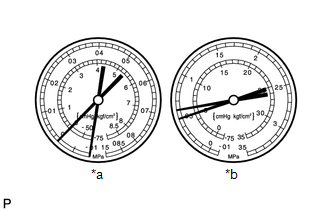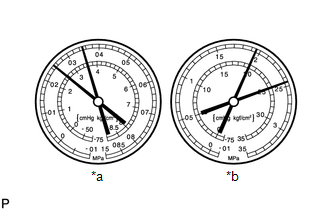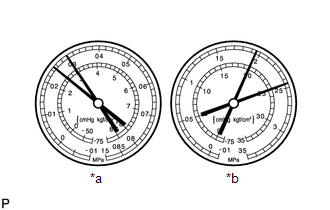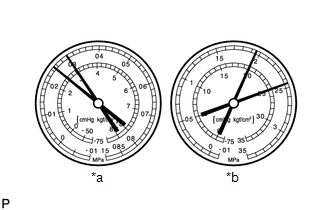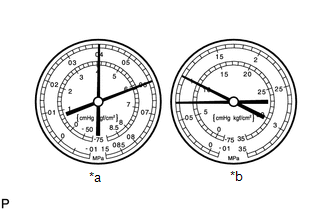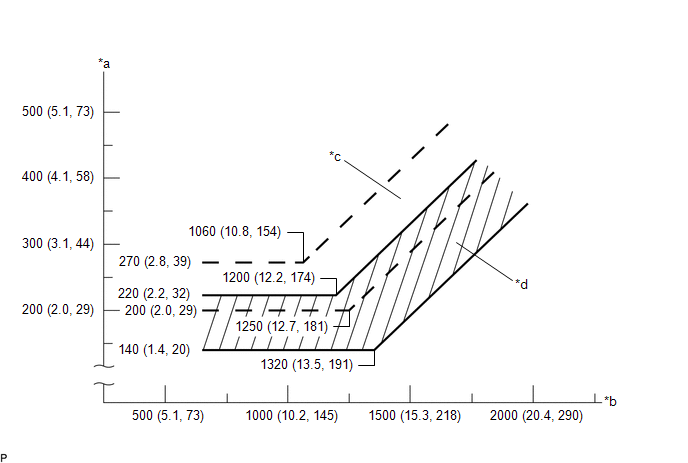Precaution
PRECAUTION
PRECAUTIONS FOR REFRIGERANT HFO-1234yf (R1234yf)
(a) Compatibility
(1)
The parts used in the refrigerant cycle, the compressor oil, etc. of an
HFO-1234yf (R1234yf) system are not compatible with a conventional
HFC-134a (R134a) system.
(b) HFO-1234yf (R1234yf) Refrigerant
(1) Always use HFO-1234yf (R1234yf) as the refrigerant.
NOTICE:
- Do not charge the system with refrigerant near open flame, as HFO-1234yf (R1234yf) is combustible.
- When charging the system with refrigerant, make sure that the area is
well ventilated (especially be careful in areas where the gas can easily
accumulate, such as under lifts and in garage pits, as the gas is
heavier than air).
- Follow any local regulations regarding combustible gases.
- Be sure to use a refrigerant recovery unit that is compatible with HFO-1234yf (R1234yf) systems.
HINT:
The
shape of the service port for refrigerant charging has an exclusive
design conforming to international standards for HFO-1234yf (R1234yf) to
prevent improper refrigerant charging.
(c) Compressor Oil (for Gasoline Model)
(1) Always use ND-OIL 12 as the compressor oil.
NOTICE:
The
oil used for HFC-134a (R134a) systems (ND-OIL 8) does not work well in
HFO-1234yf (R1234yf) systems. If the oil used for HFC-134a (R134a)
systems (ND-OIL 8) is used in an HFO-1234yf (R1234yf) system, it will
result in degradation of the refrigerant and deterioration of resin
parts.
(2) When parts of the air conditioning
system are removed, quickly block off any areas that are exposed to the
outside air with plugs, vinyl tape, etc., as the oil used for HFO-1234yf
(R1234yf) systems absorbs moisture easily.
(3) Do
not allow the compressor oil to spray, as the oil used for HFO-1234yf
(R1234yf) systems has harmful effects on acrylic resins.
(d) Compressor Oil (for HV Model)
(1) Always use ND-OIL 11 as the compressor oil.
NOTICE:
The
oil used for HFC-134a (R134a) systems (ND-OIL 8) does not work well in
HFO-1234yf (R1234yf) systems. If the oil used for HFC-134a (R134a)
systems (ND-OIL 8) is used in an HFO-1234yf (R1234yf) system, it will
result in degradation of the refrigerant and deterioration of resin
parts.
(2) When parts of the air conditioning
system are removed, quickly block off any areas that are exposed to the
outside air with plugs, vinyl tape, etc., as the oil used for HFO-1234yf
(R1234yf) systems absorbs moisture easily.
(3) Do
not allow the compressor oil to spray, as the oil used for HFO-1234yf
(R1234yf) systems has harmful effects on acrylic resins.
(e) Evacuation
(1)
When evacuating the system, be sure to use a refrigerant recovery unit,
refrigerant recycler and refrigerant charger that are compatible with
HFO-1234yf (R1234yf) systems.
(f) Refrigerant Gas Leak Inspection
(1) Use a gas leak detector to check for refrigerant gas leaks.
HINT:
Be sure to use a gas leak detector that is compatible with HFO-1234yf (R1234yf) systems.
(2) Turn the engine switch (for Gasoline Model) or power switch (for HV Model) off when checking for refrigerant leaks.
HINT:
- If the engine is running when checking for leaks, the leaking gas will
be diluted by the air from the fan and blower, making detection more
difficult.
- If the air conditioning system is operating when checking for leaks, the
refrigerant pressure in the system will decrease, making it harder for
gas to leak.
- If the air conditioning system is operating when checking for leaks, the
electronic gas leak detector may react to a sudden change in humidity
due to the humid air coming from the drain cooler hose and a faulty
judgment may be made.
PRECAUTIONS RELATED TO REMOVAL AND INSTALLATION OF PARTS
(a) If refrigerant gets in your eyes
(1) Do not rub your eyes with your hands or a cloth.
(2) Consult an eye doctor.
(b) Handling of Refrigerant (Container)
(1)
Do not heat the container. If the container is directly heated or put
into boiling water, the pressure inside the container will become
abnormally high and the container may burst.
(2) Do not drop or strike the container.
(3) Do not bring the container anywhere near your face. Always wear eye protection.
(c) Pipe Installation (for Gasoline Model)
(1) Always use new O-rings.
HINT:
When removing an O-ring, use an object with a soft tip so as not to damage the piping.
(2) Apply a sufficient amount of compressor oil (ND-OIL 12) to the O-ring.
(3) Route the hoses in the way they are naturally shaped. Do not twist or forcibly bend the hoses.
(4) Do not use cloth gloves, etc. as fibers attached to O-rings can lead to refrigerant gas leaks.
(d) Pipe Installation (for HV Model)
(1) Always use new O-rings.
HINT:
When removing an O-ring, use an object with a soft tip so as not to damage the piping.
(2) Apply a sufficient amount of compressor oil (ND-OIL 11) to the O-ring.
(3) Route the hoses in the way they are naturally shaped. Do not twist or forcibly bend the hoses.
(4) Do not use cloth gloves, etc. as fibers attached to O-rings can lead to refrigerant gas leaks.
Replacement
REPLACEMENT
PROCEDURE
1. RECOVER REFRIGERANT FROM REFRIGERATION SYSTEM
(a) for Gasoline Model:
(1) Start the engine.
(b) for HV Model:
(1) Turn the power switch on (READY).
(c) Operate the compressor under the following conditions:
|
Item | Condition |
|
Operating Time | 3 minutes or more |
|
Temperature setting | Max cold |
|
Blower speed | High |
|
Engine (for Gasoline Model) |
Idling |
| Power switch (for HV Model) |
On (READY) |
|
A/C switch | On |
This causes most of the compressor oil from the various components of the A/C system to collect in the compressor.
HINT:
It is not necessary to operate the compressor if the A/C does not operate because of compressor lock, etc.
(d) for Gasoline Model:
(1) Stop the engine.
(e) for HV Model:
(1) Turn the power switch off.
(f) Recover the refrigerant from the A/C system using a refrigerant recovery unit.
HINT:
Use the refrigerant recovery unit in accordance with the manufacturer's instruction manual.
2. CHARGE AIR CONDITIONING SYSTEM WITH REFRIGERANT
HINT:
Charge the system with refrigerant in accordance with the manufacturer's instruction manual.
(a) Perform vacuum purging using a vacuum pump or appropriate equipment.
NOTICE:
Be sure to use a refrigerant recovery unit that is compatible with HFO-1234yf (R1234yf) systems.
(b) Charge the air conditioning system with refrigerant.
Refrigerant Type:
HFO-1234yf (R1234yf)
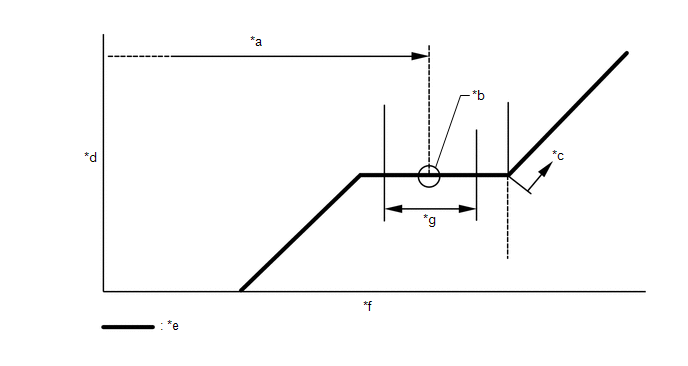
|
*a | Standard Charge Amount |
*b | Mean Value in Proper Range |
|
*c | Overcharged |
*d | High Pressure |
|
*e | Sub-cool System |
*f | Refrigerant Amount |
|
*g | +/-30 g (+/-1.05 oz) |
- | - |
Standard Charge Amount:
|
for Gasoline Model | 580 to 640 g (20.5 to 22.5 oz) |
|
for HV Model | 520 to 580 g (18.4 to 20.4 oz) |
NOTICE:
- Do not turn the A/C switch on before charging the air conditioning
system with refrigerant. Doing so may cause the compressor to operate
without refrigerant, resulting in overheating of the compressor.
- The refrigerant amount should be checked by quantity (weight).
- The graph above is shown for reference only.
HINT:
Ensure
that sufficient refrigerant is available to recharge the system when
using a refrigerant recovery unit. Refrigerant recovery units are not
always able to recover 100% of the refrigerant from an air conditioning
system.
3. WARM UP ENGINE (for Gasoline Model)
(a) Keep the A/C switch on for at least 2 minutes to warm up the compressor.
NOTICE:
To
prevent damage to the compressor, be sure to warm up the compressor
when turning the air conditioning on after removing and installing any
air conditioning system lines (including the compressor).
4. WARM UP COMPRESSOR (for HV Model)
(a) Keep the A/C switch on for at least 2 minutes to warm up the compressor.
NOTICE:
To
prevent damage to the compressor, be sure to warm up the compressor
when turning the air conditioning on after removing and installing any
air conditioning system lines (including the compressor).
5. INSPECT FOR REFRIGERANT LEAK
(a) After recharging the air conditioning system with refrigerant, inspect for refrigerant leaks using a halogen leak detector.
HINT:
Be sure to use a halogen leak detector that is compatible with HFO-1234yf (R1234yf) systems.
(b) Carry out the test under the following conditions:
| (c) Using a halogen leak detector, inspect for refrigerant leaks from the air conditioning system. |
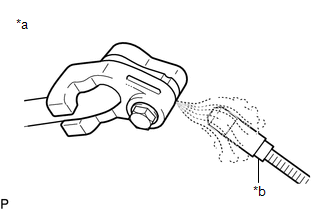 |
|
*a | Inspect for leak | |
*b | Halogen Leak Detector | | |
| (d) Bring the halogen leak detector close to the drain cooler hose with the detector power off, and then turn the detector on.
HINT:
- After the blower motor has stopped, leave the cooling unit for more than 15 minutes.
- Bring the halogen leak detector sensor under the drain cooler hose.
- When bringing the halogen leak detector close to the drain cooler hose,
make sure that the halogen leak detector does not react to volatile
gases. If it is not possible to avoid interference from volatile gases,
the vehicle should be lifted up to allow checking for leaks.
|
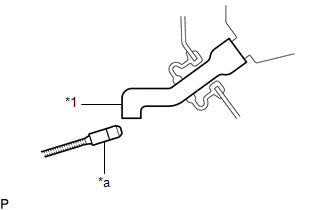 |
|
*1 | Drain Cooler Hose | |
*a | Halogen Leak Detector | | |
(e)
If a refrigerant leak is not detected from the drain cooler hose,
remove the blower motor control from the cooling unit. Insert the
halogen leak detector sensor into the unit and check for leaks.
(f)
Disconnect the pressure sensor connector and leave it for approximately
20 minutes. Bring the halogen leak detector close to the pressure
sensor and check for leaks.
HINT:
When checking for leaks, the presence of oily dirt at a joint can indicate a leak.
